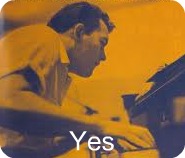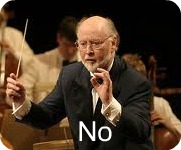main: January 2011 Archives
Leave it to the piano players to know who the piano players are. Slightly more than a year ago, Alan Broadbent introduced Rifftides readers to Chris Dawson. Now, Alan alerts us to Stephanie Trick of St Louis, Missouri. She studied classical piano from the age of five. When she was 10, her teacher introduced her to ragtime and stride. She fell in love with the genre and mastered it, and now the worldwide network of stride enthusiasts is in love with her. I wouldn't be surprised to see her following expand to a wider audience. Mr. Broadbent describes Ms. Trick as "the real deal" and comments on her "rock-solid" left hand.
If you're not accustomed to willowy young women emulating James P. Johnson, Fats Waller and Willie The Lion Smith, get used to it, is my advice. Here is Ms. Trick in concert last New Year's Eve in St. Louis with James P's "Modernistic."
Embedding is disabled on a clip of Stephanie Trick's riveting performance of Willie The Lion's "Keep Your Temper." You can see and hear it by clicking here. To learn more about her, go here.
The veteran Polish Trumpeter Tomasz Stanko's late-blooming fame puts him in demand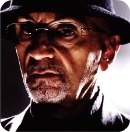 around the world. His reflective musings often inspire reviewers to compare him to Miles Davis. Davis was an inspiration, but Stanko long since absorbed, internalized and personalized the influence. Tonight he is playing in Australia at the Sydney Festival with his band of young Scandinavians. In the Sydney Morning Herald, John Shand traced Stanko's career, including his importance to the film composer Krsystof Komeda.
around the world. His reflective musings often inspire reviewers to compare him to Miles Davis. Davis was an inspiration, but Stanko long since absorbed, internalized and personalized the influence. Tonight he is playing in Australia at the Sydney Festival with his band of young Scandinavians. In the Sydney Morning Herald, John Shand traced Stanko's career, including his importance to the film composer Krsystof Komeda.
Komeda was the composer/pianist who penned scores for several Polanski films, including Rosemary's Baby. Stanko stayed for six years, absorbing the potential for a distinctly European jazz. ''Komeda started to write very modern compositions,'' recalls Stanko, ''and he needed a free [improvising] player. I was maybe the only free player in Poland at this time.''
He was the vinegar in Komeda's melodic dressings; it was only when Komeda died in 1969 that Stanko devoted himself to his own music. Often the stimulus came from poetry, painting or film. ''I was always into art. My first guru was Van Gogh, and then Modigliani, now I am really a fan of any kind of visual art.''With his current quintet - which has two Finns (pianist Alexi Tuomarila and drummer Olavi Louhivuori) and two Danes (guitarist Jakob Bro and bassist Anders Christensen) - he recorded The Dark Eyes of Martha Hirsch, inspired by an Oskar Kokoschka portrait in New York's Neue Galerie. The gallery is a 15-minute walk from Stanko's apartment, and he often goes there for stimulus.
To read the whole piece, go here.
That quintet toured Poland in 2009. Here they play a Stanko composition called "So Nice," which you are unlikely to confuse with the Brazilian pop tune of the same title.
When the National Endowment for the Arts Jazz Masters Awards ceremony and associated events happened a couple of weeks ago, I was caught on the horns of a 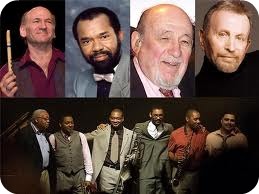 deadline dilemma and had to skip the televised proceedings. I've been catching up with the honors to David Liebman, Hubert Laws, Orrin Keepnews, Johnny Mandel and the Marsalises. Better late than never. The ceremony at Lincoln Center in New York City on January 11 ran long, although not as long as some previous years' events. It included nicely made five-minute mini-documentaries about each of the 2011 jazz masters. We'll show you two of them and lead you to the others.
deadline dilemma and had to skip the televised proceedings. I've been catching up with the honors to David Liebman, Hubert Laws, Orrin Keepnews, Johnny Mandel and the Marsalises. Better late than never. The ceremony at Lincoln Center in New York City on January 11 ran long, although not as long as some previous years' events. It included nicely made five-minute mini-documentaries about each of the 2011 jazz masters. We'll show you two of them and lead you to the others.
The group award to Ellis Marsalis and his sons Branford, Wynton, Delfeayo and Jason stirred up criticism. The criticism is water over the dam; the award went to most of that extraordinary New Orleans family. My only substantial reservation is that Dolores Marsalis, the matriarch whose strength is the family's center, wasn't named on the plaque.
The NEA portrait of Keepnews came close to giving an understanding of what a gifted producer can do for music.
To find the video portraits of all five of the masters for this year and several earlier ones, go here. To see the entire two-hour NEA ceremony in streaming video, click here. And if that isn't enough for you, click here and see a panel discussion, complete with at least one surreal speech in the guise of a question from the audience.
An old bit of confusion revived for a time this week when Mosaic Records announced a Stan Getz box set to be issued next spring. The electronic news release about the 1950s Getz quintet recordings for Norman Granz's Norgran label mentioned Getz, Bob Brookmeyer and "pianist Johnny Williams (who later became film composer John Williams)."
After several people hopped on the web with corrections, Mosaic commander-in-chief Michael Cuscuna explained, "Earlier version of the write-up got pasted in by mistake." Mosaic corrected the goof. Here is further clarification. The man on the left below is John Thomas Williams, the pianist who worked with Getz, Brookmeyer, Zoot Sims, Al Cohn and Cannonball Adderley in the '50s. The man on the right is John Towner Williams, who had a brief career as a jazz pianist and went on to Star Wars and the Boston Pops.
For a few decades the "Yes" John Williams took side trips into successful careers in banking and government. He lives in Florida and, at 82, still plays gigs, mostly solo piano. When I spoke with him this morning, he sounded content, although he allowed that he wouldn't mind having the "No" John Williams's royalty income. To further dissipate confusion, here's a rerun of a Rifftides piece about him that first appeared on April 18, 2006. It contains a link to a reissue CD of Williams' widely praised trio records.
THAT John WilliamsDuring long stretches of 1953 and '54, John Williams was the pianist in Stan Getz's quintet and quartet. Wiliams is often described in biographies as a disciple of Bud Powell who was also influenced by Horace Silver. That is true. It is also true that oxygen influences flame, a fact that tells us nothing about the differences among flames. In the population of pianists influenced by Powell and Silver, Williams was identifiable by a keyboard touch that produced a spikey, percussive, rollicking forward motion, an infectious swing. Almost in contradiction, at the same time he somehow achieved a smoothness of phrasing that invested his improvised lines with the logic of inevitability. He managed to make his listeners anticipate what was coming in a solo and yet surprise them when he got there.
Williams' first album under his own name was John Williams, a ten-inch LP on the Emarcy label, recorded in 1954. His trio had Bill Anthony on bass and the unique Detroit drummer Frank Isola, fellow members of the Stan Getz group. Williams jokes today that he often wonders who got the third copy of the album after he and his mother each bought one. It may not have been a big seller, but it quickly became a favorite of musicians and, after Emarcy pulled it, of collectors. In the 1990s, a broker of rare LPs who sold to Japanese LP zealots told me that a mint copy of John Williams was going in Japan for upwards of $300. I blush to confess that I sold him my beat-up copy for considerably less than that, making him wait while I first copied it to tape. As we listened, I hummed along to Wiliams' solos, so embedded in my brain had they become over four decades of nearly wearing out the album.
It was a puzzle, given the LP's iconic status, why Emarcy did not reissue it on CD, and why Verve did not bring it out after the company acquired the Emarcy catalog. A good guess is that the decision was made by accountants. Time has cured that ill. Copyright laws in Spain declare that after fifty years, recorded material is fair game (I'm not sure that's the exact wording of the law). So, the resourceful Fresh Sound label has put on one CD John Williams and the pianist's second Emarcy album, a twelve-inch LP called John Williams Trio, recorded in 1955. This belated event probably doesn't do much for the inflated price of the original LPs, but it is a boon to the substantial number of Williams fans who have been clamoring for a reissue. It may also gain him new fans.
The second album, done in three sessions with shifting personnel among bassists and drummers, doesn't have quite the concentrated charm of the ten-inch 1954 session. That is in part, I suspect, because Frank Isola is on only one track. Nonetheless, it has wonderful moments. Taken together, the twenty tracks capture John Williams when his playing was full of freshness, vigor and peppery lyricism. By all accounts, including the evidence of an appearance with Marian McPartland on Piano Jazz, it still is. He has never stopped playing, but he took a few decades off to become a banker and, for twenty years, a city commissioner of Hollywood, Florida. In conversation, Williams tends to deprecate his playing in the 1950s as inadequate, an evaluation that flies in the face of the wisdom of his employers--StanGetz, Bob Brookmeyer, Cannonball Adderley, Al Cohn and Zoot Sims among them--and of listeners who have been stimulated by his work for half a century.
I should point out, although by now it may be obvious, that this John Williams is not the Star Wars John Williams.
For news about the Getz Quintet reissue featuring THAT John Williams, go here.
The New Orleans Jazz and Heritage Festival yesterday announced the lineup for the 2011 edition. The festival will run the weekends of April 29-May 1 and May 5-8. In New Orleans, they still refer to the event as JazzFest. Here is a partial list of the hundreds of major attractions.
Arcade Fire, Bon Jovi, Jimmy Buffett, Kid Rock, John Mellencamp, Wilco, Willie Nelson, The Strokes, Robert Plant, Ms. Lauryn Hill, Tom Jones, Jeff Beck, Sonny Rollins, John Legend & The Roots, The Avett Brothers, Cyndi Lauper, Wyclef Jean, The Decemberists, Bobby Blue Bland, Mighty Clouds of Joy, Edie Brickell, Kebâ•˙Moâ•˙,Rance Allen, Ahmad Jamal, RAM, Punch Brothers, Ron Carter Trio, Fisk Jubilee Singers, Ivan Lins, Charlie Musselwhite.
A few of the Louisiana performers:
Trombone Shorty & Orleans Avenue, The Neville Brothers, Dr. John, Allen Toussaint, Irma Thomas, Mystikal, Pete Fountain, Kermit Ruffins & the Barbecue Swingers, Better Than Ezra, Rebirth Brass Band, Galactic, Tab Benoit, The Radiators, Cowboy Mouth, Ivan Neville˙s Dumpstaphunk, Marcia Ball, The Dirty Dozen Brass Band, Ellis Marsalis, Walter "Wolfman" Washington, Sonny Landreth, Henry Butler, Papa Grows Funk, Big Sam's Funky Nation, John Boutté, Terence Blanchard, Amanda Shaw, The New Orleans Bingo! Show, Preservation Hall Jazz Band, Johnny Sketch & the Dirty Notes, Nicholas Payton, Astral Project, Big Chief Monk Boudreaux & the Golden Eagles and Banu Gibson.
For a complete list of performers and information about the festival, go here.
JazzFest, as it was christened at its birth in the late 1960s, began as the purest of jazz festivals, integrated with a judicious smattering of associated events involving Louisiana food and culture. The 1968 and '69 festivals, along with certain years at Newport and Monterey, were among the music's milestone large events. They were not big money makers and they did not fit some New Orleans movers' and shakers' vision of what a festival should be in a city whose motto is "Let The Good Times Roll." These were the headliners in 1968, JazzFest's first year:
Louis Armstrong, Duke Ellington, Woody Herman, Dave Brubeck & GerryMulligan, Pete Fountain, Ramsey Lewis, Max Kaminsky, Lurlean Hunter, Art Hodes, Pee Wee Russell, Cannonball Adderley, Carmen McRae, Ray Bryant, Teddi King and Gary Burton.
Among dozens of New Orleans musicians were:
Sharkey Bonano and his Kings of Dixieland, Al Belletto, Danny Barker, the Papa French band, the Olympia Brass Band, Louis Cottrell, Willie Tee And The Souls, the Dukes of Dixieland, June Gardner Quartet and Armand Hug.
Most of the concerts in '68 and '69 were sit-and-listen affairs in the Municipal Auditorium, with a sprinkling of riverboat cruises and events in Jackson Square. The focus was on jazz and its central role in the history and life of the city.
In 1970, George Wein's Festival Productions company took over JazzFest from the locals who created it, renamed it the New Orleans Jazz and Heritage Festival and—with promotional skill and canny marketing—made it the world-famous party it is today. The fact that the bash is overwhelmingly pop, secondarily heritage and minimally jazz doesn't bother the promoters and doesn't bother New Orleans. It was probably inevitable in the city that care forgot, that JazzFest would become a big, fat, swirling celebration full of R&B, rock, country, gospel, Zydeco and soul. In the 2011 lists above, you may have to do a little searching to find the names of jazz artists.
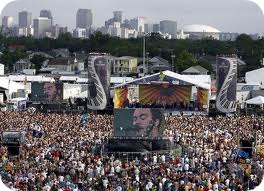 More than five years after Katrina, with the city recovering but much of it still resembling a post-war nightmare, a party called a jazz festival symbolizes New Orleans' determination to recover. That speaks of a spirit that rises from within New Orleanians and cuts through a malaise of failed leadership, politics and bureaucracy. For eight years, I was a New Orleanian. I understand that spirit. It grows out of the curious combination of laissez faire and obstinance that animates folks whose blood has a component of coffee with chicory.
More than five years after Katrina, with the city recovering but much of it still resembling a post-war nightmare, a party called a jazz festival symbolizes New Orleans' determination to recover. That speaks of a spirit that rises from within New Orleanians and cuts through a malaise of failed leadership, politics and bureaucracy. For eight years, I was a New Orleanian. I understand that spirit. It grows out of the curious combination of laissez faire and obstinance that animates folks whose blood has a component of coffee with chicory.
Partying, food, boogying and getting down are wonderful. Few Orleanians would disagree with any of that. But this is the city that gave us Louis Armstrong, Sidney Bechet, Jelly Roll Morton, Henry "Red" Allen, Barney Bigard, Raymond Burke, Danny Barker, Paul Barbarin, James Black, Johnny Vidacovich, Al Belletto, Terence Blanchard, Donald Harrison and the Marsalises.
It is clear that popular taste no longer embraces jazz as a central element. It is equally clear that the New Orleans Jazz and Heritage Festival is here to stay as a kaleidoscope of entertainment. It would be welcome if the city also had room for a festival that honored and nurtured the music that is the living symbol of the New Orleans spirit. Somehow, jazz ended up with a bit part in what the natives still call JazzFest.
Rifftides reader John Bolger writes with a suggestion:
Somebody has posted the legendary interview between Paul Desmond and Bird on YouTube. I had a seen transcript of this before but never heard the interview. Rare and wonderful! Thought you might like to know - might be worth piece in Rifftides.
It might, indeed. In the spring of 1954, Desmond and Charlie Parker were guests on John McLellan's radio program on WHDH, Boston. In two previous shows, McLellan hadn't been able to get much out of Parker. This time, Desmond gently hijacked the interview and Bird opened up to him. In a letter to his friend Jimmy Lyons, quoted in Take Five: The Public and Private Lives of Paul Desmond, Desmond wrote, "I don't know whether it was professional courtesy or the half-pint of bourbon, but old Charlie talked up a storm."
A year later, at the age of 34, Charlie Parker was dead. They say.
For more on the friendship between Parker and Desmond, and Desmond's determination not to be a junior Birdman, see Take Five the book.
Not long ago, we told you about stealth comments intended to lure Rifftides readers to websites that sell stuff. This just came in from the United Kingdom:
just signed up at www.artsjournal.com and wanna say hi to all the guys/gals of this board!
That cheery greeting was disguised as a comment about a Rifftides post from March 2, 2006 and evidently sent in hopes that we would publish it with the link to an advertisement for an acne treatment. The ruse didn't work, but it sent the staff back to look at the original post. Oddly, the bogus comment is the only one the story has attracted in the nearly six years it has been sitting in the archives. The story came from a reliable source, so, we're going to run it by you again.
Several versions of a joke usually beginning something like, "A note walks into a bar...." are floating around the internet. Buddy DeFranco forwarded the most elaborate I've seen. The Rifftides management makes no claims about the reliability of the musicology in this tale:
A C, an E-flat, and a G go into a bar. The bartender says: "Sorry, but we don't serve minors." So, the E-flat leaves, and the C and the G have an open fifth between them. After a few drinks, the fifth is diminished: the G is out flat. An F comes in and tries to augment the situation, but is not sharp enough.A D comes into the bar and heads straight for the bathroom saying, "Excuse me. I'll just be a second."
An A comes into the bar, but the bartender is not convinced that this relative of C is not a minor.
Then the bartender notices a B-flat hiding at the end of the bar and exclaims: "Get out now! You're the seventh minor I've found in this bar tonight."
The E-flat, not easily deflated, comes back to the bar the next night in a 3-piece suit with nicely shined shoes. The bartender (who used to have a nice corporate job until his company downsized) says: "You're looking sharp tonight, come on in! This could be a major development." This proves to be the case, as the E-flat takes off the suit, and everything else, and stands there au naturel.
Eventually, the C sobers up, and realizes in horror that he's under a rest. The C is brought to trial, is found guilty of contributing to the diminution of a minor, and is sentenced to 10 years of DS without Coda at an upscale correctional facility. On appeal, however, the C is found innocent of any wrongdoing, even accidental, and that all accusations to the contrary are bassless.
The bartender decides, however, that since he's only had tenor so patrons, the soprano out in the bathroom, and everything has become alto much treble, he needs a rest - and closes the bar.
If you really want to know about the acne treatment, use the "Contact Me" link in the center column and the staff will send you the url. You need not be a resident of the UK to apply.
There is good news for jazz listeners in Southern California. The Jazz Bakery can stop roaming. That modern-day rarity, a major jazz club in Los Angeles, the Bakery lost its lease in 2009 and has been presenting concerts in a variety of halls, moving from one spot to another. Now it can reestablish itself in Culver City near where it started nearly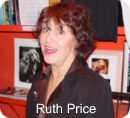 two decades ago. A grant from the Annenberg Foundation and an agreement with a Culver City municipal agency will help make the new building a reality where founder Ruth Price wanted it. For details, see Chris Barton's report in The Los Angeles Times.
two decades ago. A grant from the Annenberg Foundation and an agreement with a Culver City municipal agency will help make the new building a reality where founder Ruth Price wanted it. For details, see Chris Barton's report in The Los Angeles Times.
During my Los Angeles period, the Bakery was a favorite haunt. Let's hope that the new place will have the intimacy that made it a pleasure to hear music like this, played by Howard Alden and the late George Van Eps at the Jazz Bakery in 1994.
To see a Rifftides archive piece about Ruth Price, a bit of Jazz Bakery history and a video of Ruth singing, click here.
Rifftides reader Mark Stryker sent this reaction to the previous entry. Mr. Stryker is the music critic of The Detroit Free Press. He has good ears.
Just a coda re: "Moonlight in Vermont," whose unusual lyrics were written by John Blackburn. The A section words are actually in the form of a haiku, with 5-7-5 syllable pattern. Nor do the lyrics rhyme. Also, a note on the interpretation: Whiting takes a big (and to my ear unfortunate) breath leading from the bridge into the final A section, separating the words "lovely" and "evening," which breaks up the single image in the lyric that continues over the bar line: "People who meet in this romantic setting/are so hypnotized by the lovely evening summer breeze." Without disrespecting Whiting's gifts, compare to how Jo Stafford sings it. Singing a slightly alternate lyric, she doesn't take the breath where Whiting does, making it through the bar line before grabbing some quick air after the first word ("shadows") of the new 8 bars. But you can tell she's trying to keep the line focused into single, unbroken thought, and her phrasing does give the impression of a more liquid, expressive legato, especially since the arrangement slipped into rubato on the bridge.
Of course, the master of using breath-control technique, the legato line and savvy phrasing to heighten the meaning of a lyric is Frank Sinatra. "Moonlight" was always a showcase for him in that way. He takes it 'way further than Stafford, connecting the bridge to the last A with a suspended phrase that raises the tension to a peak before a wonderful release, making it all the way to the end of the sentence in the second bar before breathing; he even ornaments the word "evening" with a little downward portamento slide. The second time through the tune he ups the ante in what for me is one of the most electric moments in all of Sinatra Land. Over a rubato accompaniment, he sneaks a breath between "hypnotized" and "by" and then suspends time f-o-r-e-v-e-r. When he finally slides into the final 8 bars, the key slides up a step (thanks, Billy May) and the combination of Sinatra's phrasing and the arrangement has the music reaching for the stars. Wow.
News of Margaret Whiting's death at 86 on Monday must have sent her fans to the shelves in search of her recording of "Moonlight in Vermont." She recorded the song in 1943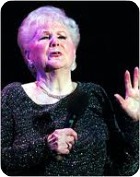 when she was 19. It helped make her a star, and she stayed on the charts well into the 1960s, surviving even as rock and roll displaced scores of her pop music contemporaries.
when she was 19. It helped make her a star, and she stayed on the charts well into the 1960s, surviving even as rock and roll displaced scores of her pop music contemporaries.
Johnny Mercer did not write the lyric for "Moonlight in Vermont," but when he was the creative power at Capitol Records he chose the song for Whiting. Mercer and Frank Loesser helped shape her singing from the time she was the grade school daughter of their fellow songwriter Richard Whiting. In a passage from Gene Lees' Mercer biography Portrait of Johnny, Whiting recalled how Mercer prepared her for the record session.
"...Johnny said, 'I want you to think, what does Vermont mean to you?'"I said, 'A calendar with a church in the snow.'
"He said, 'there are more images.'
"I said, 'Well, there's got to be summer, winter, fall. Fall. Everybody goes to see Vermont in the fall for the leaves.'
"He said, 'I want you to think of those pictures. I want you to think of the coming of spring. I want you to think of summer, people swimming and people walking, people having a lovely time outdoors.'
"So we go in and record it and I'm envisioning all these pictures. It gave me something to go on. That's what he taught me and that's what Loesser taught me. Pick up that sheet music and look at those lyrics and make them mean something. Read the lyric aloud, over and over and over. Recite it until you get it. Your own natural instincts will tell you."
Here's the record: Trumpeter Billy Butterfield and his orchestra, with Margaret Whiting's vocal.
For an obituary of Margaret Whiting, go here.
Partially blind, totally brilliant, for decades James Thurber (1894-1961) entertained readers with the incisiveness and wit of his stories and drawings. His most famous story i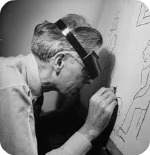 s probably "The Secret Life of Walter Mitty," which was distorted into a film that Thurber detested. Almost everything he did was for print, most of it in The New Yorker. There were exceptions. He wrote the hit play The Male Animal, appeared on stage in an adaptation of his stories called A Thurber Carnival, and collaborated with the composer David Raksin on an animated version of The Unicorn in the Garden, the most famous of more than 75 fables Thurber wrote. The fables inevitably ended with punch lines that served as morals.
s probably "The Secret Life of Walter Mitty," which was distorted into a film that Thurber detested. Almost everything he did was for print, most of it in The New Yorker. There were exceptions. He wrote the hit play The Male Animal, appeared on stage in an adaptation of his stories called A Thurber Carnival, and collaborated with the composer David Raksin on an animated version of The Unicorn in the Garden, the most famous of more than 75 fables Thurber wrote. The fables inevitably ended with punch lines that served as morals.
This is not the anniversary of Thurber's birth, his death or of any special occasion connected with him. It is simply a good day to watch The Unicorn in the Garden and listen to Raksin's lovely score.
This is a classic collection of Thurber stories.
It is better to have loafed and lost, than never to have loafed at all.
It is better to know some of the questions than all of the answers.
One martini is all right. Two are too many, and three are not enough.
Progress was all right. Only it went on too long.
There is no exception to the rule that every rule has an exception.
Flip Philipp & Ed Partyka Dectet, Hair Of The Dog (ATS). In their third album as co-leaders, Philipp and Partyka make a substantial addition to the recorded history of medium-sized jazz groups. From bands led by Fletcher Henderson through Red Norvo, Duke Ellington, Woody Herman, Miles Davis, 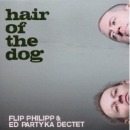 Gerry Mulligan, James Moody, Shorty Rogers, Dave Brubeck, Teddy Charles, Rod Levitt, Bill Kirchner and Charles Mingus—among many others— arrangers for six to eleven pieces have achieved flexibility that the mass of a sixteen-piece band inhibits. Philipp is an Austrian vibraharpist active in jazz who for twenty years has been principal percussionist of the Vienna Symphony Orchestra. Partyka is an American trombonist who heads the jazz department at the University of Music and Dramatic Arts in Graz, Austria. They are gifted composers and arrangers who relish referring to styles that preceded them, but are distinctively modern in harmony and voicing. In "Woman Trouble," Partyka uses sinuous wa-wa effects right out of Ellington and Philipp gives his Milt Jackson tribute "Groove Bag" a boogaloo sensibility, but they are not in the retro business.
Gerry Mulligan, James Moody, Shorty Rogers, Dave Brubeck, Teddy Charles, Rod Levitt, Bill Kirchner and Charles Mingus—among many others— arrangers for six to eleven pieces have achieved flexibility that the mass of a sixteen-piece band inhibits. Philipp is an Austrian vibraharpist active in jazz who for twenty years has been principal percussionist of the Vienna Symphony Orchestra. Partyka is an American trombonist who heads the jazz department at the University of Music and Dramatic Arts in Graz, Austria. They are gifted composers and arrangers who relish referring to styles that preceded them, but are distinctively modern in harmony and voicing. In "Woman Trouble," Partyka uses sinuous wa-wa effects right out of Ellington and Philipp gives his Milt Jackson tribute "Groove Bag" a boogaloo sensibility, but they are not in the retro business.
The music has freshness, vigor, precision, daring and, often, a kind of wacky amiability. Philipp's "Minors" opens with a series of downward glissandos across the band, abruptly morphs into what could be car-chase music or something adapted from Raymond Scott, then settles into lightning solos by Philipp and pianist Oliver Kent, interspersed with tightly written ensemble punctuations. Partyka's voicings in "Hair of the Dog" give the band expansiveness that belies its medium size. They provide Jure Pukl a cushy platform for his tenor saxophone in one of several impressive solos by the young Slovenian. All of the musicians except drummer Christian Salfellner get solo time. Salfellner contributes swing and sensitivity, commodities more rare and valuable than drum solos. "Kotzen Beim Steuerberater" has an exhilarating improvised duet between Robert Bachner on euphonium and the audacious bass clarinetist Wolfgang Schiftner. Fabian Rucker's heartfelt baritone saxophone takes center stage in Partyka's richly orchestrated "Let it Go, Ro." The title, an anagram, refers to the piece's original setting as Verdi's "La donna è mobile." Kent, Philipp, and Rucker on bass clarinet, float through Philipp's "Time," arranged to languid effect by Partyka. The solos are consistent reminders of the abundant pool of jazz talent in Central Europe, but it is Partyka's and Philipp's writing that gives this album its lasting value.
Wadada Leo Smith and Ed Blackwell, The Blue Mountain's Sun Drummer (Kabell). Ed Blackwell's drumming never lets you forget that he was from New Orleans. Blackwell, who died in 1992, was a master of polyrhythmic complexity. He helped Ornette Coleman and Don Cherry pioneer free jazz. Part of him was always the little boy listening to Paul Barbarin, Monk Hazel and other drummers whose spirit he absorbed as he grew up in the Crescent City. In this newly-released 1986 encounter, he teams with trumpeter Smith in 10 duets that together have the character of a suite. Blackwell and Smith played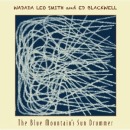 these spontaneous pieces in a broadcast on the radio station of Brandeis University. As he interacts with Smith, intimations of the New Orleans parade beat combine with the iconoclasm that in the 1960s Blackwell brought to modern jazz drumming and Smith to the new thing of Chicago's Association for the Advancement of Creative Musicians. "The Blue Mountain's Sun Drummer," the title tune, sets Smith's clarion calls, trills and flurries of notes against Blackwell's off-meter bass drum thuds, tom-tom bumps, glittering explosions of cymbal splashes and chattering snare patterns. Still, this music is not crowded. The two do not produce the sturm un drang that often make free jazz seem undifferentiated walls of sound. The underlying waltz feeling of "Mto: The Celestial River" is anything but intimidating.
these spontaneous pieces in a broadcast on the radio station of Brandeis University. As he interacts with Smith, intimations of the New Orleans parade beat combine with the iconoclasm that in the 1960s Blackwell brought to modern jazz drumming and Smith to the new thing of Chicago's Association for the Advancement of Creative Musicians. "The Blue Mountain's Sun Drummer," the title tune, sets Smith's clarion calls, trills and flurries of notes against Blackwell's off-meter bass drum thuds, tom-tom bumps, glittering explosions of cymbal splashes and chattering snare patterns. Still, this music is not crowded. The two do not produce the sturm un drang that often make free jazz seem undifferentiated walls of sound. The underlying waltz feeling of "Mto: The Celestial River" is anything but intimidating.
Smith and Blackwell make use of quietness and, in some cases, silence. On flugelhorn and, briefly, flute, for "Sellassie-I," Smith establishes a hymn-like melody and Blackwell maintains an implacable beat on his hi-hat, making spare comments and punctuations on other parts of his set. The effect is hypnotic as the piece melds into "Seven Arrows in the Garden of Light" and takes on increasing intensity. Smith reflects his orderly composer's mind as he improvises with thematic development that is even more evident in "Buffalo People: A Blues Ritual." He is an inventor of melodies. For all of his ability to generate thunder, Blackwell reminds us that in a close listening and playing encounter with an equally thoughtful musician, he could be lyrical. Smith is flourishing in the new century, with a number of interesting projects. It is good to have this fresh and timeless record of his collaboration with a master of modern drumming.
Bobby Hacket, Bob Haggart: V-Disc Parties (Jazz Unlimited) The glories of Hackett's cornet and Haggart's arrangements fill 21 tracks recorded for American service men and women during and after World War Two. The first five pieces are by a recreation of the Original Dixieland Jazz Band. They include two of the original members of the ODJB 26 years after the New Orleans band made the world's first jazz records. Trombonist Eddie Edwards and drummer Tony Spargo were still vital, a reminder of how rapidly jazz developed in its first three decades;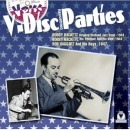 bebop was in its early stages when these records were made in 1943. Clarinetist Brad Gowans and pianist Frank Signorelli fill out the ODJB revival roster. There is little evidence in the Hackett ODJB sides that bop is about to pop, or in eight others he led in 1948 that Charlie Parker, Dizzy Gillespie and other boppers were now flourishing. What is evident is that among post-Beiderbecke cornetists, Hackett occupies a unique place. The perfection of his tone, flow of lyrical ideas and swing can astonish a listener. His companions on the 1948 tracks include guitarist Eddie Condon, clarinetist Peanuts Hucko, trombonist Cutty Cutshall, baritone saxophonist Ernie Carceres and drummer Morey Feld, recorded beautifully and all playing at the tops of their games.
bebop was in its early stages when these records were made in 1943. Clarinetist Brad Gowans and pianist Frank Signorelli fill out the ODJB revival roster. There is little evidence in the Hackett ODJB sides that bop is about to pop, or in eight others he led in 1948 that Charlie Parker, Dizzy Gillespie and other boppers were now flourishing. What is evident is that among post-Beiderbecke cornetists, Hackett occupies a unique place. The perfection of his tone, flow of lyrical ideas and swing can astonish a listener. His companions on the 1948 tracks include guitarist Eddie Condon, clarinetist Peanuts Hucko, trombonist Cutty Cutshall, baritone saxophonist Ernie Carceres and drummer Morey Feld, recorded beautifully and all playing at the tops of their games.
In the eight-piece band that Haggart leads in a 1947 V-Disc session, there are more than hints of bebop. Haggart announces it with a direct quote from Gillespie's "Oop Bop Sh'Bam" as the introduction to a novelty called "Possum Song." His ensemble writing includes boppish licks that attest to his openness to new ideas and his ability to make them serve his music. The music is swing, but some of Haggart's arrangements are akin to what young writers like Neil Hefti and George Handy were doing for Woody Herman and Boyd Raeburn at the time. The backgrounds he puts behind the soloists on "Haggart's Lady" (based on "What Is This Thing Called Love,") are echoes of Tadd Dameron's "Hot House." He transforms the chestnuts "Indian Love Call" and "Bye Bye Blues" into boppish original works. Haggart's eight-piece band features Hucko, alto saxophonist Toots Mondello, the little-known tenor saxophonist Art Drellinger, pianist Stan Freeman, Haggart on bass and Chris Griffin, an overlooked trumpet hero of the big band era. Griffin's lead and solo work here is remarkable. I don't know how much circulation these recordings got among soldiers, sailors, Marines and Coastguardsmen in the 1940s. They deserve plenty now.
At the end of the piece two exhibits below, I wrote that I would depend on Rifftides readers to tell us about the Emil Viklický-Scott Robinson concert the night before last. Even better, journalist and blogger Michael Steinman took his video camera to the Bohemian National Hall of the Czech Center in New York.
Viklický played a lovely Petrof grand piano. Robinson used only three of the instruments from his armory—soprano and tenor saxophones and euphonium. No ophicleide or slide soprano this time. Thanks to Mr. Steinman, here are two pieces from the concert of January 5, 2011. In his introduction to the first, Robinson talks about the pair's long friendship. He is at a distance from the camera's microphone; you may want to temporarily increase the volume of your speakers.
For all nine videos from the concert, go here. To explore Michael Steinman's YouTube channel, go here. You will find previous Viklický and Robinson posts in the Rifftides archives.
Digital video surprises pop up on the web. Here is an ad hoc edition of the Gerry Mulligan Quartet. The valve trombonist is Mulligan's frequent collaborator Bob Brookmeyer. Ray Brown, bass, and Art Blakey, drums, may have done this with Mulligan just once. YouTube tells us when, 1981. But who knows where?
Comments provide some of the most valuable content in Rifftides. We encourage everyone to submit comments. The staff decides which ones appear and is tolerant, but there are limits. We evaporate comments that would commercialize the blog by offering links to products or services, especially those of a—er—personal nature. Here is a comment allegedly in response to a post about Jelly Roll Morton. It had a link to a Las Vegas escort service. Considering some of the New Orleans parlors where Jelly played, maybe that makes a kind of sense, even if the comment itself does not.
It is very interesting for me to read this blog. Thank you for it. I like such topics and anything that is connected to them. I would like to read more on that blog soon.
Some of the sneak comments don't have as much substance as that one. Here, however, is one reacting to reviews of Randy Weston and John McNeil that offers valuable information—if you own a bearded dragon.
I know the bearded dragon definitely does absorb some water via its
vent region and skin. Making them live and eat out of a container made of salt would be like having them ingest a lot of salt per day.
 Can't argue with that. The link was to a site selling Playdough. Maybe someone out there in cyberspace can explain the connection.
Can't argue with that. The link was to a site selling Playdough. Maybe someone out there in cyberspace can explain the connection.
If you would like to react to what you actually read, watch or hear on Rifftides, please use the "Comments" link found at the end of each item. We would like to hear from you, unless you're running the Bearded Dragon Playdough Escort Service.
Rifftidesers who live in or near New York City have the opportunity this week to 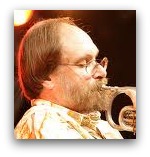 hear and see together two musicians who have often received favorable mention in Rifftides—and elsewhere. Here is the announcement from one of them, the multi-instrumentalist Scott Robinson.
hear and see together two musicians who have often received favorable mention in Rifftides—and elsewhere. Here is the announcement from one of them, the multi-instrumentalist Scott Robinson.
Hello everybody.Just wanted to let anyone who might be in New York know about the free duo concert I am doing this Wednesday with my dear friend and colleague Emil Viklický, who is making a rare stateside appearance from the Czech Republic. Emil is perhaps the most highly regarded pianist of his country and we have participated in many projects together, going back to the band we formed in college in 1977. Please come out if you can... Happy New Year to everyone!
Emil Viklický/Scott Robinson Duo
Wed., Jan. 5, 7:00 PM
Bohemian National Hall
Czech Center New York
321 E. 73 St., New York City
646-422-3399You'll notice that Mr. Robinson mentioned "free." When is the last time you attended a free concert by two world-class musicians? For information about them and the hall, go here. To my regret, 3,000 miles of wintry distance prevent my being there. I'll depend on Rifftides readers for their accounts.
Sorry for the late notice, but I just found out about this. The adventurous radio station  KBOO-FM in Portland, Oregon, is broadcasting a six-part series about the musician Butch Morris. The second part is this evening—soon. For how to tune in, go to the end of this piece. Morris is not merely a composer, arranger, bandleader or conductor. Or he is all of those things and more. Our colleague Howard Mandel, a specialist on the avant garde, says Morris's music "is not jazz." Or it is. This promotional clip for a film about Morris will give you a hint.
KBOO-FM in Portland, Oregon, is broadcasting a six-part series about the musician Butch Morris. The second part is this evening—soon. For how to tune in, go to the end of this piece. Morris is not merely a composer, arranger, bandleader or conductor. Or he is all of those things and more. Our colleague Howard Mandel, a specialist on the avant garde, says Morris's music "is not jazz." Or it is. This promotional clip for a film about Morris will give you a hint.
The KBOO program runs tonight from 8:00 to 10:00 pm PST, 11:00 pm to 1:00 am EST. To listen to it, go here and click on "Listen Now." In the Portland area, you'll find it on 90.7.
If you're interested in a full sample of how Butch Morris works, here he is at a festival in Italy last August. The players are J. Paul Bourelly (Guitar), On Ka'a Davis (Guitar), Harrison Bankhead (Acoustic Bass), Greg Ward (Sax), Evan Parker (Sax), Pasquale Innarella (Sax), Hamid Drake (Percussions), Chad Taylor (Drums -- Vibraphone), Riccardo Pittau (Trumpet), Meg Montgomery (Electro Trumpet), Alan Silva (Synthesizer), Tony Cattano (Trombone), Joe Bowie (Trombone), David Murray (Sax)—an elite of the outcats.
The Rifftides staff hopes that your 2011 will be as happy as this New Year's Eve performance by Venezuela's Simón Bolívar Youth Orchestra. The conductor is Gustavo Dudamel, music director of the Los Angeles Philharmonic.
Feliz Año Nuevo
AJ Ads
AJ Blogs
AJBlogCentral | rssculture
Terry Teachout on the arts in New York City
Andrew Taylor on the business of arts & culture
rock culture approximately
Laura Collins-Hughes on arts, culture and coverage
Richard Kessler on arts education
Douglas McLennan's blog
Dalouge Smith advocates for the Arts
Art from the American Outback
Chloe Veltman on how culture will save the world
For immediate release: the arts are marketable
No genre is the new genre
David Jays on theatre and dance
Paul Levy measures the Angles
Judith H. Dobrzynski on Culture
John Rockwell on the arts
innovations and impediments in not-for-profit arts
Jan Herman - arts, media & culture with 'tude
dance
Apollinaire Scherr talks about dance
Tobi Tobias on dance et al...
jazz
Howard Mandel's freelance Urban Improvisation
Focus on New Orleans. Jazz and Other Sounds
Doug Ramsey on Jazz and other matters...
media
Jeff Weinstein's Cultural Mixology
Martha Bayles on Film...
classical music
Fresh ideas on building arts communities
Greg Sandow performs a book-in-progress
Harvey Sachs on music, and various digressions
Bruce Brubaker on all things Piano
Kyle Gann on music after the fact
Greg Sandow on the future of Classical Music
Norman Lebrecht on Shifting Sound Worlds
Joe Horowitz on music
publishing
Jerome Weeks on Books
Scott McLemee on books, ideas & trash-culture ephemera
theatre
Wendy Rosenfield: covering drama, onstage and off
visual
Public Art, Public Space
Regina Hackett takes her Art To Go
John Perreault's art diary
Lee Rosenbaum's Cultural Commentary
